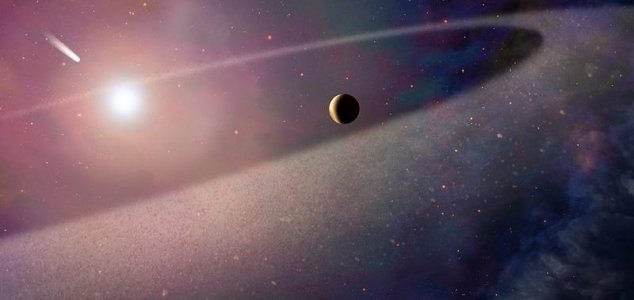Space & Astronomy
December 5, 2019 · 0 comments
0 comments

Is this what will ultimately become of our solar system ? Image Credit: NASA, ESA, and Z. Levy (STScI)
A white dwarf star is essentially what remains of a main sequence star after it has exhausted all of its hydrogen and gone through its red giant phase (the same thing will also happen to the Sun.)
Until now, it was thought that planets very close to a star could not survive this process.
"This star has a planet that we can't see directly, but because the star is so hot it is evaporating the planet, and we detect the atmosphere it is losing," said study lead author Dr Boris Gaensicke.
"This discovery is major progress because over the past two decades we had growing evidence that planetary systems survive into the white dwarf stage."
"We've seen a lot of asteroids, comets and other small planetary objects hitting white dwarfs, and explaining these events requires larger, planet-mass bodies further out."
"In a sense, [this] is providing us with a glimpse into the very distant future of our own solar system."
Source: Independent | Comments (0)
Planet found orbiting white dwarf in world first
By T.K. RandallDecember 5, 2019 ·
 0 comments
0 comments
Is this what will ultimately become of our solar system ? Image Credit: NASA, ESA, and Z. Levy (STScI)
Astronomers have discovered a huge planet orbiting the burnt-out husk of a star that was once like the Sun.
Situated around 2,000 light years from Earth, the planet, which is around four times larger than the star it orbits, was discovered by astronomers from the University of Warwick's Department of Physics and the Millennium Nucleus for Planet Formation (NPF) at the University of Valparaiso.A white dwarf star is essentially what remains of a main sequence star after it has exhausted all of its hydrogen and gone through its red giant phase (the same thing will also happen to the Sun.)
Until now, it was thought that planets very close to a star could not survive this process.
"This discovery is major progress because over the past two decades we had growing evidence that planetary systems survive into the white dwarf stage."
"We've seen a lot of asteroids, comets and other small planetary objects hitting white dwarfs, and explaining these events requires larger, planet-mass bodies further out."
"In a sense, [this] is providing us with a glimpse into the very distant future of our own solar system."
Source: Independent | Comments (0)

The Unexplained Mysteries
Book of Weird News
AVAILABLE NOW
Take a walk on the weird side with this compilation of some of the weirdest stories ever to grace the pages of a newspaper.
Click here to learn more

Support us on Patreon
BONUS CONTENTFor less than the cost of a cup of coffee, you can gain access to a wide range of exclusive perks including our popular 'Lost Ghost Stories' series.
Click here to learn more
Israel, Palestine and the Middle-East
United States and the Americas
Spirituality, Religion and Beliefs
Russia and the War in Ukraine
Total Posts: 7,746,711 Topics: 323,572 Members: 203,045
Not a member yet ? Click here to join - registration is free and only takes a moment!
Not a member yet ? Click here to join - registration is free and only takes a moment!





























Please Login or Register to post a comment.